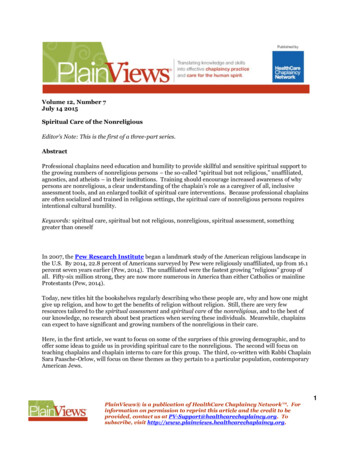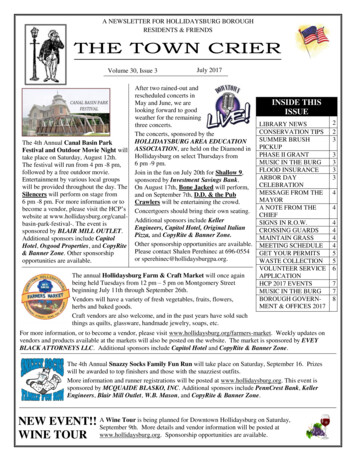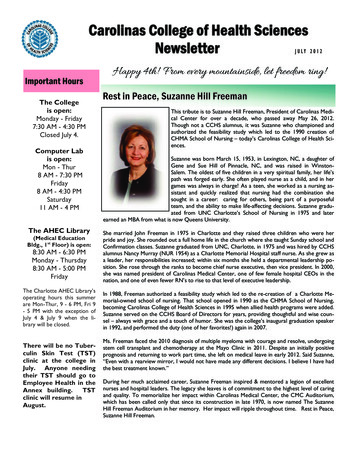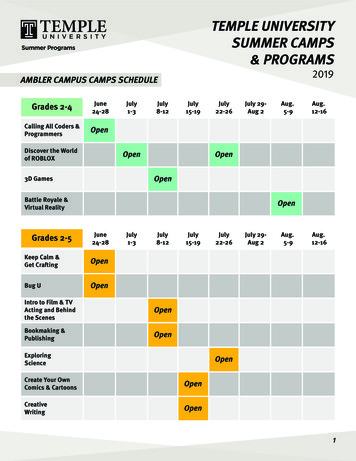
Transcription
Volume 12, Number 7July 14 2015Spiritual Care of the NonreligiousEditor's Note: This is the first of a three-part series.AbstractProfessional chaplains need education and humility to provide skillful and sensitive spiritual support tothe growing numbers of nonreligious persons – the so-called “spiritual but not religious,” unaffiliated,agnostics, and atheists – in their institutions. Training should encourage increased awareness of whypersons are nonreligious, a clear understanding of the chaplain’s role as a caregiver of all, inclusiveassessment tools, and an enlarged toolkit of spiritual care interventions. Because professional chaplainsare often socialized and trained in religious settings, the spiritual care of nonreligious persons requiresintentional cultural humility.Keywords: spiritual care, spiritual but not religious, nonreligious, spiritual assessment, somethinggreater than oneselfIn 2007, the Pew Research Institute began a landmark study of the American religious landscape inthe U.S. By 2014, 22.8 percent of Americans surveyed by Pew were religiously unaffiliated, up from 16.1percent seven years earlier (Pew, 2014). The unaffiliated were the fastest growing “religious” group ofall. Fifty-six million strong, they are now more numerous in America than either Catholics or mainlineProtestants (Pew, 2014).Today, new titles hit the bookshelves regularly describing who these people are, why and how one mightgive up religion, and how to get the benefits of religion without religion. Still, there are very fewresources tailored to the spiritual assessment and spiritual care of the nonreligious, and to the best ofour knowledge, no research about best practices when serving these individuals. Meanwhile, chaplainscan expect to have significant and growing numbers of the nonreligious in their care.Here, in the first article, we want to focus on some of the surprises of this growing demographic, and tooffer some ideas to guide us in providing spiritual care to the nonreligious. The second will focus onteaching chaplains and chaplain interns to care for this group. The third, co-written with Rabbi ChaplainSara Paasche-Orlow, will focus on these themes as they pertain to a particular population, contemporaryAmerican Jews.1PlainViews is a publication of HealthCare Chaplaincy Network . Forinformation on permission to reprint this article and the credit to beprovided, contact us at PV-Support@healthcarechaplaincy.org. Tosubscribe, visit http://www.plainviews.healthcarechaplaincy.org.
MethodsOur study took us to diverse disciplines and types of resources. The 2007 and 2014 Pew studies onreligion in America were touchstones, as well as Pew’s 2013 International Study of Patterns ofReligiosity. We read in sociology of religion, New Atheist writings, psychology and religion, theology,interfaith chaplaincy, ethics, history, and spiritual direction. Reading narratives was a particularpleasure. We reviewed many spirituality websites. We interviewed several scholars, as well as humanistchaplains working in both university and health care settings. Attendance at a number of workshops,and leading a number ourselves, contributed to our learning. For all the growth in writing about the“spiritual but not religious,” there is no central resource on providing spiritual care to this group.ResultsThe American demographic of those with no religious affiliation is quite diverse and paradoxical. Of the22.8 percent of the general American population with no religious affiliation, 31 percent self-identify asatheist or agnostic. The majority, 69 percent, describe themselves as “nothing in particular.” Strikingly,30 percent of these “nothing in particulars” consider religion important in their lives. Ninety-twopercent believe in God, and 44 percent pray daily (Pew, 2014). Thus, they have earned the title “spiritualbut not religious” (SBNR). They have a high retention rate, so that 53 percent of those raised withoutreligious affiliation continue in that path into adulthood (Pew, 2014). These religiously unaffiliated areincreasing in reverse proportion to age (PRRI, 2013). The LGBTQ demographic is less religiouslyaffiliated than the general population (Pew, 2013a). American Jews are less likely than other Americansto believe in God, although many atheist Jews remain strongly identified as Jews (Pew, 2013b). Atheiststhemselves show great diversity in approach (Hafiz, 2013).DiscussionSpirituality and religion can be thought of as a Venn diagram of two differently sized, intersecting ovals,the larger oval representing spirituality, and the smaller oval, religion.Although no consensus definition of spirituality exists, we suggest “the personal search for meaning andpurpose, and relationship with and trust of ‘Something Greater Than Oneself’ (SGTO) that is personallymeaningful.” Important themes here are meaning, relationship, and Something Greater ThanOneself. We find helpful Sam Keen’s observation that we are in the presence of the spiritual wheneverthe following feelings arise: wonder, awe, gratitude, anxiety, joy, grief, reverence, fascination,empowerment, vocation, compassion, outrage, hope, humility, trust, and absolute dependency (Keen,2010).Religion, similarly, has no consensus definition. For the purposes of this article, we suggest “the beliefs,practices, and attitudes associated with an organized group or community that usually has a commonauthoritative text or narrative that mediates the community’s relationship with a commonly agreed uponSomething Greater Than Oneself.”The word “religion” is so charged that many people now define themselves by exclusion, as in “noreligious affiliation” or “spiritual but not religious.” Yet, what does it mean when so many from thisgroup do believe in God, pray, and consider religion important?Our chaplaincy skills can help us here. Many people have stories to tell about their negative orambivalent experience of “religion,” just as others have stories about how positive “religion” has been intheir lives. It is our discipline’s approach to honor the truth in a person’s narrative even when that2PlainViews is a publication of HealthCare Chaplaincy Network . Forinformation on permission to reprint this article and the credit to beprovided, contact us at PV-Support@healthcarechaplaincy.org. Tosubscribe, visit http://www.plainviews.healthcarechaplaincy.org.
person’s experience is different than our own. Compassionate curiosity and humility can help us offerhospitality to those who have been hurt, rejected, or have chosen to leave their religion behind.The Table of Contents of a book published by Zondervan last year – entitled Forgive Us: Confessionsof a Compromised Faith (Cannon, 2014) -- reads like a list of legitimate reasons some people mightself identify as not religious:1.2.3.4.5.6.7.Sins against God’s CreationSins against Indigenous PeopleSins against African Americans and People of ColorSins against WomenSins against the LGBTQ CommunitySins against ImmigrantsSins against Jews and Muslims.Whether the problem lies with religion itself, or the distortion of religion, is irrelevant to the person whohas been harmed or excluded. Religion has come to carry a negative valence for that person. When achaplain walks into a room, humility about their own religious affiliation is necessary if there is to be anychance of the chaplain assisting the patient in identifying and drawing on their spiritual resources. Ifchaplains can face honestly the hurt done in the name of the religious traditions we represent, perhapswe can befriend the part of us that is “spiritual but not religious.” This self-awareness can help uswelcome the spirituality of the nonreligious person before us.American culture has deeply entrenched prejudice against atheism. The extent of this was a surprise forus. After much struggle, the Boy Scouts of America now allows gay boys into theirmembership. Atheists, however, remain disqualified for membership, and no public outcry hasmotivated the organization to amend this categorical exclusion (Winston, 2013a). Bullying againstatheists is well documented in our nation’s high schools (Stewart, 2012). Last year both the US Navy andthe House of Representatives refused to allow humanist chaplains into the military, despite more than20 percent of the women and men in the armed forces being religiously unaffiliated (Banks, 2014;MAAF, 2012; and Winston, 2013b). Seven states still have laws on their books disqualifying atheistsfrom running for public office (Goodstein, 2014). Nearly half of Americans would disapprove if a familymember married an atheist, and more than half of Americans would view negatively the atheism of apresidential candidate (Goodstein, 2014).Another surprise was learning that some nonreligious people resent the idea that they might beconsidered “spiritual” (Navarro, 2014). The allergy to “religion” sometimes spreads to rejection of“spirituality,” too. Our traininghasled us to view every person as spiritual, yet it is our task as chaplainsto engage with the patient usingthe patient’s language of meaning. Chaplains can indeed do their workeffectively without employing the language of religion or spirituality: What is important in your life?Where are your significant relationships?What values are most important to you?What gives you strength in challenging times?What is disrupting access to these resources right now?What sociology of religion calls the skill of “code switching” (Cadge, 2013), or being able to converse inmultiple vernaculars, is essential in skillful and inclusive chaplaincy.3PlainViews is a publication of HealthCare Chaplaincy Network . Forinformation on permission to reprint this article and the credit to beprovided, contact us at PV-Support@healthcarechaplaincy.org. Tosubscribe, visit http://www.plainviews.healthcarechaplaincy.org.
When approaching a patient who registered in the hospital as “None” or “Unaffiliated,” open-heartedinquiry regarding religious or spiritual identity can be saved until a positive relationship has beenestablished or the patient has raised the topic. Our professional tasks can still be accomplished throughfocused conversation using secular language: assessment of the person’s areas of spiritual distress, if any,identification of their spiritual resources, and intervention to help them ameliorate their distress andincrease their well-being.We must become ever more aware of our own religious and cultural specificity. Like the water that isinvisible to the swimming fish, so often religious culture and language can be invisible to the chaplainwho is immersed in them. A chaplain’s use of his or her own religious/spiritual language in the contextof another’s nonreligious values is a micro-aggression, however unintentional, the harm is done by thechaplain’s word choice. We chaplains must keep growing our hospitality to the nonreligious.Codes of EthicsThe intention of our national chaplaincy organizations’ codes of ethics is clear about this. The APCCode of Ethics, for example, directs members to “affirm the religious and the spiritual freedom of allpersons and refrain from imposing doctrinal positions or spiritual practices on persons whom theyencounter in their professional role as chaplain” (APC, 2000). We chaplains have often understood thisdirective in the context of respecting another’s religion, but we must appreciate its additional relevanceto respecting the integrity of the meaning-making of the nonreligious and unaffiliated as well.Two Inclusive Spiritual Assessment ModelsIt is important to have spiritual assessment models in our toolkits that work for the religious as well asmodels that work for the SBNR, agnostics, atheists, unaffiliated, and nonreligious. Spiritual careliterature offers dozens of spiritual assessment tools. At Hebrew Senior Life where Rev. Thiel works,chaplains serve people in independent living, assisted living, rehabilitation, acute care, palliative care,hospice, and chronic hospital care. About 85 percent of the patients and residents are Jewish. Chaplainsat Hebrew Senior Life generally use two spiritual assessment tools to guide their work.One spiritual assessment tool is the religious mapping model that originated in the work of MordechaiKaplan, the founder of the Reconstructionist movement of Judaism, and is now used widely bysociologists of religion. Kaplan offered three axes on which to consider a Jew’s relationship to Judaism:belief, behavior, and belonging (Kaplan, 1948). This model allows for the wide diversity of ways in whicha Jew can be Jewish. Certainly, some Jews hold strong religious beliefs, follow the Mitzvot, and have astrong bond of belonging to the Jewish people. At the same time, others may not “believe” in God, yetthey attend synagogue (behavior), and understand their identity as deeply Jewish (belonging). Eachindividual will have a map unique to him or her. A chaplain will focus on helping the person accessspiritual resources from whichever axes support the resident’s needs during their current situation. Wehave found Kaplan’s model to be applicable to non-Jews as well.The second spiritual assessment tool considers seven themes (see Appendix A). It is designed to uselanguage inclusive of both religious and secular worldviews. Each of the themes has its own continuum: Love and Belonging (loneliness à feeling loved and secure)Forgiveness (guilt or regret à reconciliation and peacefulness)Trust (fear à confidence in someone/something of high reliability and veracity)Hope (despair à a sense of positive possibility)Meaning (ennui or boredom à a sense of congruence or purpose)4PlainViews is a publication of HealthCare Chaplaincy Network . Forinformation on permission to reprint this article and the credit to beprovided, contact us at PV-Support@healthcarechaplaincy.org. Tosubscribe, visit http://www.plainviews.healthcarechaplaincy.org.
In an end-of-life context, we add:Gratitude (bitterness à thankfulness)In a context of dementia, we add:Identity (loss of self-awareness à recognition of selfhood and uniqueness).This model identifies areas of spiritual distress that might be ameliorated, and areas of strength that canbe drawn on to increase spiritual well-being. In a different sort of setting, a chaplain might well addother themes to the model which are customized to that context.Enhancing Our Toolkits to Serve the NonreligiousAs long as we are clear about our role and goals as chaplains, and understand the contexts in which weserve, we can confidently add many new tools to our toolkit. We can wholeheartedly assist a patient instrengthening their relationship with their SGTO’s, be those God, family, friends, colleagues, students,nature, on-line communities, the arts, values, and/or other things important to them. We areaccustomed as chaplains to arranging for access to religious rituals such as Shabbat services or theEucharist. Arranging for a pet to visit may bring comparable comfort to a person whose most importantrelationship is with their pet. Phone calls, Skype, CaringBridge, and e-mail are hardly religious rites, yetin certain situations, they can each provide spiritual infusions. Ipads provide today’s chaplains withamazing access to spiritual resources: prayers and inspirational readings, to be sure, but also the abilityto help a patient see a current picture of their hometown or favorite place, to listen to a much-lovedmusical piece, to “go on a pilgrimage” to a meaningful site, or to spend time with their favorite glories ofthe natural world.Photos in the patient’s room can be understood as spiritual resources. For the nonreligious, photos mayserve as “sacred text,” recalling formative loved ones and defining moments of life. Cooking or talkingabout recipes can rekindle memories of love, family, and caring for others. Gardening taps into themysteries of growth, beauty, and death, and can serve as something of a legacy for the one who plantsknowing they may not live to see the blooming. Assisting a patient in doing acts of kindness (writingbirthday cards to soldiers, for a patriotic veteran or a person concerned about a loved one servingoverseas) or advocacy (writing letters about causes one cares about, signing e-mail petitions, voting in animportant election) can support their spiritual well-being. Helping a patient write an ethical will, whichsums up their highest values and offers a moral legacy to those they love andwill leave behind, can be ofparticular importance to those who lack a belief in an afterlife.Watching or listening to a game played by the patient’s favorite sports teams, reading familiar poetry,bringing knitting materials to a life-long knitter – any of these might be, for the appropriate person, agood fit for their own spiritual rituals and connections to their SGTO’s.“Open-eyed prayer” is a simple yet powerful tool for use with the nonreligious. The chaplain can expressa wish at the close of a visit that sums up the content and deep feeling of the encounter, as a prayer wouldif prayer were part of the patient’s language of spirituality: I will be thinking of you tomorrow and hoping your surgery goes well.May you find clarity and peace as you consider your choices.I wonder what options might open that we haven’t even thought of yet .I will carry your joy with me today!Such simple phrases punctuating the end of the visit, said with care, let the patient know they wereheard, they are not alone in their situation, there is a possibility that things will not always feel as awful5PlainViews is a publication of HealthCare Chaplaincy Network . Forinformation on permission to reprint this article and the credit to beprovided, contact us at PV-Support@healthcarechaplaincy.org. Tosubscribe, visit http://www.plainviews.healthcarechaplaincy.org.
as they do now, and/or their joy does impact the world. Like a well-designed spontaneous prayer, athoughtfully worded personalized blessing often brings a tear to a patient’s eye.Chaplains may benefit from some new resources. A therapy dog, with their chaplain in tow, can openmany a door and relationship with a wary, nonreligious patient. Devotional materials for atheists(Kopitz, 1999), accessible poetry (McDargh, 2011), nature photography books, and ipads loaded withmusic likely to suit the demographics of the setting can be added to the department’s library.Chaplains can benefit from including verbatim learning in their professional continuing education. Thepresentation of a verbatim on a chaplain’s visit with a nonreligious person, an atheist, or someone whoself-identifies as SBNR could serve as a useful focus of a chaplaincy department’s continuing educationsession.Appendix B contains such a verbatim, with commentary, as an example of how a group of chaplaininterns learned about staying within a patient’s vocabulary of meaning to maximize the effectiveness of aspiritual care visit.The Importance of ContextAll good spiritual care must be contextualized to the setting as well as the person. Each chaplain must beconversant in the religious and spiritual patterns of the institution they serve. Regional variations inaffiliation certainlyexist in the US. The unaffiliated are now the predominant tradition in the West, andthe second largest group in New England (Pew, 2015). Whites are more likely than both blacks andHispanics to be unaffiliated, and men more likely than women (Pew, 2015). Hospitals serving primarilypediatric patients are apt to have a higher prevalence of pre-religious patients and unaffiliated familymembers. Geriatric settings may have a greater proportion of religiously affiliated patients than generalhospitals do, and, at the same time, elders who have kept developing psychologically and spiritually mayhold religious perspectives much broader and more universal than they did earlier in life (Chinen, 1989;Erikson and Erikson, 1998).Our particular careers in Jewish and pediatric settings have helped us to learn some of the tools andapproaches that are useful in serving the unaffiliated. We believe that all persons deserve skillful andsensitive spiritual care, incorporating cultural competence and religious/spiritual nuance appropriate tothem. We are hopeful that our profession will grow to be as open and skilled in serving the nonreligiousin our various settings as it has been in serving the religious.References1.2.3.4.5.6.Ai, A. L. and McCormick, T.R. (2010). Increasing Diversity of Americans’ Faiths Alongside BabyBoomers’ Aging: Implications for Chaplain Intervention in Health Settings. Journal of HealthCare Chaplaincy, 16:1-2, 24-41. Accessed May 19, 2014.Association of Professional Chaplains (2000). Code of Ethics. www.professionalchaplains.orgBanks, A. M. (2014). Navy faces suit over denying humanist chaplain. Religion News Service,November 6.Cadge, W. (2013). Paging God: Religion in the Halls of Medicine. University of Chicago Press.Cannon, M. E., Harper, L. S., Jackson, T. and Rah, S-C. (2014). Forgive Us: Confessions of aCompromised Faith. Grand Rapids, MI: Zondervan.Chinen, A. B. (1989). In the Ever After: Fairy Tales and the Second Half of Life. Wilmette, IL:Chiron Publications.6PlainViews is a publication of HealthCare Chaplaincy Network . Forinformation on permission to reprint this article and the credit to beprovided, contact us at PV-Support@healthcarechaplaincy.org. Tosubscribe, visit http://www.plainviews.healthcarechaplaincy.org.
.25.Erikson, E. H. and Erikson, J. M. (1998). The Life Cycle Completed. Extendedversion. W.W.Norton, 1998.Goodstein, L (2014). “In Seven Sates Atheists Push to End Largely Forgotten Ban.” NewYorkTimes, December 6.Hafiz, Y. (2013). Atheist Study Reveals That Non-Believers Are Just As Varied As People OfFaith. The Huffington Post, July 13. Accessed July 16, 2013.Hebrew SeniorLife (2015). HSL Spiritual Assessment Tool.Kaplan, M. (1948). The Future of the American Jew. New York: Macmillan.Keen, S. (2010). In the Absence of God: Dwelling in the Presence of the Sacred. New York:Harmony Books.Kopitz, Barbara (1999). Morning Meditations: Daily Meditations for SecularHumanists. Farmington Hills, MI: International Institute for Secular Humanist Judaism.McDargh, J. (2011). Imagining the Real: The Art of Poetry and the Art of PastoralAttending. Pastoral Psychology online, 15 March.Military Association of Atheists and Freethinkers (2012). Department of Defense ReligiousPreference and Chaplain Survey. www.militaryatheists.orgNavarro, Noel (2014). Personal e-mail communication with M. M. Thiel. August 7.Pew Research (2015). America’s Changing Religious Landscape, Appendix D: Region byReligious Tradition.Pew Research Religion and Public Life Project (2013b). “A Portrait of JewishAmericans.” n-beliefsattitudes-culture-survey/]. Accessed May 19, 2014.Pew Research (2013a). A Survey of LGBT Americans.Pew Research (2007). US Religious Landscape Survey.Pew Research (2014). US Religious Landscape Survey.Public Religion Research Institute (2013). Religion, Values, Immigration Reform Survey. InChristian Century, March 9, 2014.http://religions.pewforum.org/Stewart, K. (2012). The Good News Club: The Christian Right’s Stealth Assault on America’sChildren. PublicAffairs.Winston, K. (2013a). One Scouts ban remains intact: Atheists. Religion News Service May 30.Winston, K. (2013b). Humanist Military Chaplains Rejected by Congress. Religion NewsService, July 25.Rev. Mary Martha Thiel is the Director of Clinical Pastoral Education at Hebrew SeniorLife in Bostonand a UCC minister. An alumna of Bryn Mawr College and Union TheologicalSeminary (New York), Mary Martha has spent her entire career in healthcarechaplaincy. Starting out at Calvary Hospital in the Bronx, a palliative carehospital, then directing the Chaplaincy at Massachusetts General Hospital,consulting to CPE centers in transition, and creating a Jewish geriatric CPEprogram at Hebrew SeniorLife, Mary Martha has enjoyed stretching the bounds ofpastoral care. Themes throughout her work have been spiritual care at the end oflife, teaching healthcare providers about integrating spiritual caregiving into thepractice of their own disciplines, and expanding religious and cultural competencyin spiritual care. Mary Martha has been a certified chaplain and CPE Supervisor for over 20 years,and is the author of many articles.She wishes to acknowledge grant support from the Louisville Institute.7PlainViews is a publication of HealthCare Chaplaincy Network . Forinformation on permission to reprint this article and the credit to beprovided, contact us at PV-Support@healthcarechaplaincy.org. Tosubscribe, visit http://www.plainviews.healthcarechaplaincy.org.
Rev. Mary Robinson is the Director of the Chaplaincy at Boston Children's Hospitaland a UCC minister. An alumna of Vassar College, the New School for SocialResearch and DrewTheological School, Mary also completed a Fellowship in MedicalEthics at Harvard Medical School. She has been working in pediatrics for over 25years, and trained in Godly Play with Jerome Berryman.Correspondence related to this article should be addressed to Rev. Mary Martha Thiel, Spiritual CareDepartment, Hebrew SeniorLife, 1200 Centre Street, Boston, Massachusetts, 02131. ix AHebrew SeniorLife Spiritual Assessment Model ( HSL 2015)1. LOVE and BELONGING hesedThe need to love and be loved; to belong; to feel a connection with family, friends, community, people,and/or God. This often presents as loneliness.Spiritual Care focus: Offering relationship, appreciation, affection, facilitating connections to others(individuals and groups). Nurturing a sense of relatedness, a feeling of being interwoven in the fabric oflife, and held by the ongoing kindness of people and/or God.2. FORGIVENESS and RECONCILIATION teshuvah u’mekhilaThe need to forgive and to be forgiven, to heal broken relationships with people, self, institutions, theworld, and/or God, and to address any unfinished business. This often presents as guilt.Spiritual Care focus: Offering rituals and liturgies of forgiveness, and seeking closure and/orreconciliation in relation to significant others. Working to attain wholeness through forgiveness.3. TRUST emunahThe need to find trust, or faith toward self, others, and/or God. This often presents as fear.Spiritual Care focus: Reducing anxiety by being a non-anxious presence and by showing faithfulnessin attendance and fidelity to promises. Exhibiting full acceptance of other and commitment to their wellbeing. Finding centeredness based in trust and faith that life is manageable or that comfort can be foundin faith.4. HOPE tikvahThe need to have hope in looking ahead. This often presents as despair.Spiritual Care focus: Helping a person grieve old hopes and identify new hopes, and offeringconsistent relationship. Looking to the future with a sense that each new day can hold promise andmeaning.8PlainViews is a publication of HealthCare Chaplaincy Network . Forinformation on permission to reprint this article and the credit to beprovided, contact us at PV-Support@healthcarechaplaincy.org. Tosubscribe, visit http://www.plainviews.healthcarechaplaincy.org.
5. MEANING kavanah:The need for one’s life to matter, and to retain dignity. For one’s actions, past, present, and future tohave import. This often presents as feelings of meaninglessness or ennui.Spiritual Care focus: Exploring the meaning of experiences, Offering opportunities for meaningfulparticipation in daily life, to do life review, and possibly an ethical will. Fostering a commitment that lifeitself is meaningful.6. GRATITUDE hodayahThe deep desire to express thankfulness in appreciation of the blessings of life.Spiritual Care focus: Being fully present for a person as they verbalize, sing, write, pray, and smile inexpression of gratitude. Receiving gratitude. Increasing awareness of deep-seated joy in life’s blessings,and offering thanks.7. IDENTITY neshamah:The need to continue living true to one’s unique identity, and to not be confined or defined by one’sillness or diminishments.Spiritual Care focus: Exploring resources for knowing earlier identity, building on it in conversationand ritual, building a unique relationship with person. Helping a person sustain their unique spirit inthe world.(HSL, 2015)Appendix BThe VerbatimThis verbatim conversation is adapted and shared with the permission of the student who wrote it (amale rabbinical student retired from the business world). All identifying information of the patient hasbeen modified for purposes of confidentiality.Chaplain Intern: “C”Visit # with this person: 3Time and length of visit: 15:30 40 minutesWhat I want to learn from writing up this conversation: I have been finding it very difficult toget into spiritual conversation with men. No matter how many lines I put out there, it seems that I justcan’t bridge the gap. Having said that, I also know that there is something comforting about thecompanionship for the men, and perhaps it’s just me needing to learn how to be that non-anxiouspresence and accepting whatever each man has to give.The PersonPerson’s pseudonym: MaxInstitution and unit: [a nursing home]Date of admission: 3 years previous to this visitAge: 95Gender: M9PlainViews is a publication of HealthCare Chaplaincy Network . Forinformation on permission to reprint this article and the credit to beprovided, contact us at PV-Support@healthcarechaplaincy.org. Tosubscribe, visit http://www.plainviews.healthcarechaplaincy.org.
Race/Ethnicity: CaucasianFamily status: WidowerNumber of children: Two daughters, two sonsReligious affiliation/practice growing up: JewishReligious affiliation/practice now: JewishHome location (local or transplanted): Raised his family in working class part of city, then movedto an affluent suburb, then to an eleg
religion in America were touchstones, as well as Pew's 2013 International Study of Patterns of Religiosity. We read in sociology of religion, New Atheist writings, psychology and religion, theology, interfaith chaplaincy, ethics, history, and spiritual direction. Reading narratives was a particular pleasure. We reviewed many spirituality .











